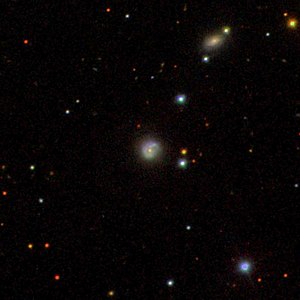IC 1753
| Galaxy IC 1753 |
|
|---|---|

|
|
| IC 1753 & IC 1752 | |
| AladinLite | |
| Constellation | triangle |
|
Position equinox : J2000.0 , epoch : J2000.0 |
|
| Right ascension | 01 h 57 m 19.3 s |
| declination | + 28 ° 35 ′ 21 ″ |
| Appearance | |
| Morphological type | E? |
| Brightness (visual) | 14.0 mag |
| Brightness (B-band) | 15.0 mag |
| Angular expansion | 0.40 × 0.4 |
| Surface brightness | 12.1 mag / arcmin² |
| Physical data | |
| Redshift | 0.033984 +/- 0.000140 |
| Radial velocity | 10.188 +/- 42 km / s |
|
Stroke distance v rad / H 0 |
(461 ± 32) x 10 6 ly (141.2 ± 9.9) Mpc |
| history | |
| discovery | Stéphane Javelle |
| Discovery date | 17th November 1903 |
| Catalog names | |
| IC 1753 • PGC 7353 • CGCG 503-061 • MCG + 05-05-033 • IRAS F01544 + 2821 • KUG 0154 + 283B • 2MASX J01571930 + 2835212 • NSA 130806 | |
IC 1753 is a galaxy of Hubble type E? in the constellation Triangle in the northern sky . It is estimated to be 461 million light years away from the Milky Way and has a diameter of about 55,000 ly. It probably forms a gravitationally bound pair with IC 1752 .
The galaxies NGC 780 and NGC 784 are located in the same area of the sky .
The object was discovered by Stéphane Javelle on November 17, 1903 .
